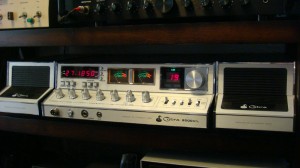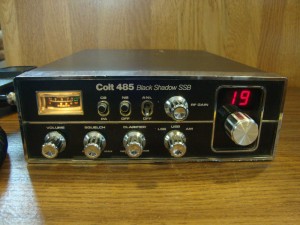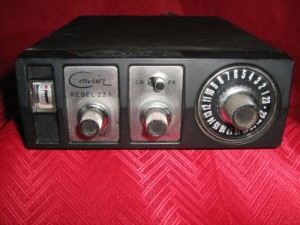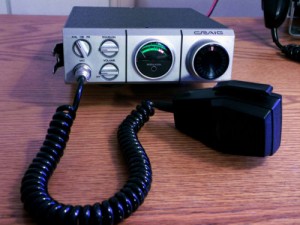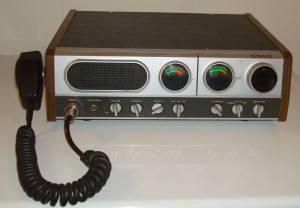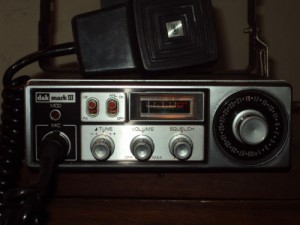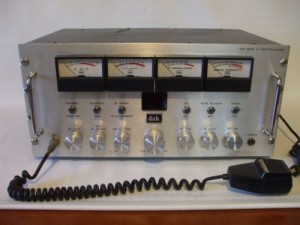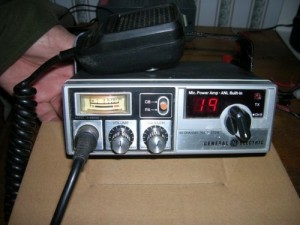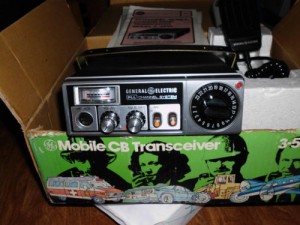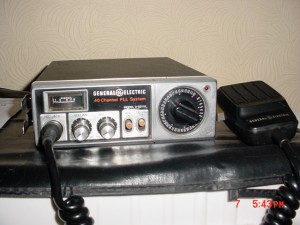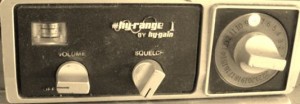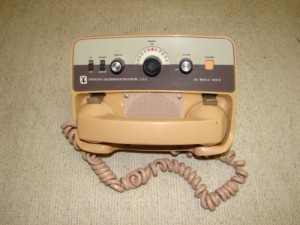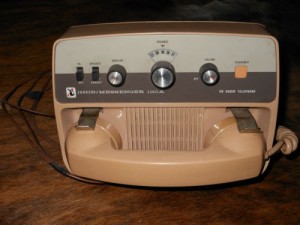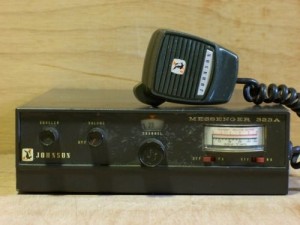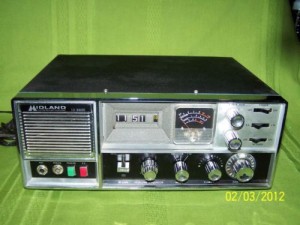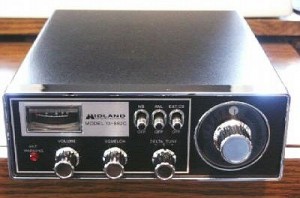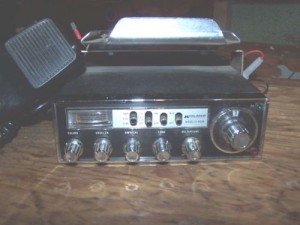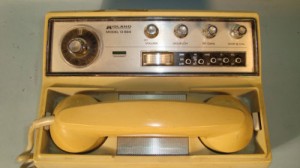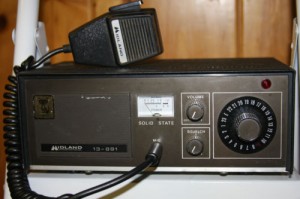Here is the famous Cobra 2000 base station. Introduced in the early 1980s, this radio has been a favorite of serious CB operators ever since. The built-in frequency counter makes it especially popular with freebanders/outbanders. A very attractive radio, shown here with both matching speakers. Most of the Dynascan 2000s found today on the used market are missing one or both of the speakers. New, it sold for around $400. Even today, a used Cobra 2000 in good condition fetches $200-300 on eBay. Those which have NOT been modified and are in stock original condition are worth the most money.
Cobra Dynascan CB Radio Model List & Guide
The original Cobra CB radios were manufactured by Dynascan Corporation. In fact, Dynascan was responsible for developing the world’s first CB radio. The year was 1963. The new radio was called the Sidewinder. In 1993, the company name was officially changed from Dynascan to Cobra Electronics Corporation. Today, Cobra CB radios continue to be produced. It is probably the most well-known line of citizens band transceivers in the world.
Here are many of the Cobra model numbers. I have included a brief description of each radio. Many are featured here on Drew’s Radio Site. If you notice a particular model is missing from the list, please let us know!
COBRA 19 – Cobra’s bare bones budget 23 channel AM mobile. Features volume, squelch, modulation light, channel selector, and 4 pin mic jack. That’s all!
COBRA 19M – 23 channel AM mobile variation of the Cobra 19. The 19M adds a small vertical S/RF meter.
COBRA 19XS – Inexpensive 1980s 40 channel AM mobile. Made in Korea. Similar to Cobra 19 PLUS but with a large analog meter instead of the newer LED bar graph meter.
COBRA 21 – This 23 channel AM mobile is one tick up from the 19. The Cobra 21X adds mic gain control, ANL, CB/PA switch, and a large lighted S/RF meter.
COBRA 21X – Updated version of the Cobra 21. The mic gain control becomes DynaMike on this 23 channel AM mobile.
COBRA 21 XLR – 40 channel AM mobile version of the Cobra 21/21X. An LED channel display with dimmer control replaces the previous model’s channel indicator dial.
COBRA 25LTD CLASSIC – Mid-level 40 channel AM mobile. Features DynaMike, RF gain control, channel display bright/dim switch, receive/transmit light, and instant channel 9 switch.
COBRA 25LTD WX CLASSIC – 40 channel AM mobile. The WX CLASSIC adds reception of all 7 National Weather Service VHF channels to the 25LTD. Frequencies received are 162.400 Mhz, 162.425 Mhz, 162.450 Mhz, 162.475 Mhz, 162.500 Mhz, 162.525 Mhz, and 162.550 Mhz.
COBRA 29 – This deluxe 23 channel AM mobile was a favorite with truck drivers. Features RF gain and Delta Tune controls. Plus ANL and NB, modulation and transmit lights, plus that traditional Cobra large lighted S/RF meter.
COBRA 85 – Budget 23 channel AM base station. Features are minimal, but the Cobra 85 does have a large lighted S/RF meter.
COBRA CAM 89 – 23 channel AM base station. Resembles a Cobra 139 XLR but without SSB mode.
COBRA 89XLR – 40 channel AM base station. As with it’s 135XLR and 139XLR sideband cousins, the 89XLR replaces the CAM 89’s channel indicator dial with an LED digital channel readout. A combination SWR/modulation meter is substituted for the CAM 89’s modulation-only meter.
COBRA 98 – Early tube type 23 channel AM base station. Easily identified by the “BK 23 Channel Citizens Band Transceiver” lettering on top of the front panel.
COBRA 134 – Rare black-faced 23 channel AM/SSB mobile. Not as many bells and whistles as the more expensive Cobra 138. Features include ANL, RF gain control, and transmit indicator light.
COBRA 135 – The “cadillac” of Cobra 23 channel AM/SSB base stations! In addition to all the knobs and lights, the 135 features a 1970s “flip petal” digital clock with alarm.
COBRA 135XLR – 40 channel AM/SSB base station. This is the 40 channel upgrade of the Cobra 135. As with the 139XLR, the previous channel indicator dial has been replaced with an LED digital readout. Otherwise, appearance is the same as the 135 it replaces.
COBRA 138 – 23 channel AM/SSB mobile. Very popular up until the introduction of 40 channel models in January, 1977. Includes DynaMike, Voice Lock, ANL/NB, RF gain, and the vintage large Cobra S/RF meter.
COBRA 138XLR – 40 channel AM/SSB mobile. Updated version of the Cobra 138, adding tone control, channel display dimmer, and full 40 channel operation.
COBRA 139 – 23 channel AM/SSB base station. Not as fancy as the Cobra 135, but a solid performer and a very popular radio during the mid-1970s.
COBRA 139 XLR – 40 channel AM/SSB base station. Very similar in appearance to the 139. Substitutes an LED digital channel readout in place of the 139’s channel indicator dial.
COBRA 142 GTL – 40 channel AM/SSB base station. Updated version of the Cobra 139XLR, adding RX and TX lights. Also, the lower front panel is silver on the 142GTL vs black on the 139XLR.
COBRA 146GTL – Entry level 40 channel AM/SSB mobile. Little brother to the Cobra 148 GTL. Basic features include ANL/NB, Voice Lock, RF gain, and transmit light.
COBRA 148GTL – Cobra’s classic 40 channel AM/SSB mobile. Always a top performer. Features large lighted S/RF/SWR meter, Voice Lock, DynaMike, receive/transmit indicator light, high/low tone switch, and bright/dim channel display switch.
COBRA 1000GTL – Basically, a Cobra 2000GTL without SSB capability. Appearance is nearly identical. As with the 2000, the Cobra 1000GTL features a built-in frequency counter and requires an external speaker. Since the 1000 does not have sideband, the fine tuning knob is labeled “Delta Tune” instead of Voice Lock. Instead of an ‘AUX’ jack, you get a ‘RECORD’ jack. Also note the dimensions of the meters is slightly different. Meters are NOT interchangeable between the Cobra 1000GTL and 2000GTL.
COBRA 2000GTL – The one everybody wants! Considered by many to be the ultimate 40 channel AM/SSB base station. Built-in frequency counter. Numerous other features including DynaMike Plus (power mic), large rectangular S/RF and SWR/modulation meters, clock with alarm, headphone jack, aux (tape) jack, and external speaker. The 2000GTL does not have an internal speaker. Keep this in mind if you purchase a used one since many used 2000s do not include the speaker.
THIS IS A WORK IN PROGRESS TO BE CONTINUED. I LOVE THESE OLD COBRAS AS MUCH AS YOU DO!
Colt 485 Black Shadow 40 Channel AM/SSB Mobile CB Radio
Colt manufactured an attractive line of CB radios. Because the brand was introduced in 1977, all were 40 channel units. This Colt 485 Black Shadow SSB is a full-featured mobile radio which includes single sideband capability. You didn’t often find Colts in discount or department stores. Instead, they were available primarily from CB specialty retailers.
Courier Rebel 23+ 23 Channel AM Mobile CB Radio
Dating from the early 1970s, the Rebel 23+ was Fanon Courier’s entry-level 23 channel mobile CB radio. Just the basics with volume, squelch, channel selector, and a small meter. This small and simple unit got the job done at a price everyone could afford. If you had purchased one new, you would have paid around $130.
Craig 4104 23 Channel AM Mobile CB Radio
This good looking 23-channel mobile is a Craig 4104. Craig CB radios featured unique styling and good performance. Despite this, they were never big sellers. Because if this, you very rarely see them today. Where I grew up in Minneapolis, Team Electronics is the only retailer that I remember carrying Craig transceivers.
Craig 4201 23 Channel AM Base CB Radio
This Craig 4201 was the base station version of the 4104 mobile. Like it’s 12 volt DC sister, the 4201 also featured unique, sleek styling and good performance for the money. But since Craig CB radios never sold in large numbers, you don’t see many of them around today. Most of the surviving Craig electronic products from this era are car stereos with 8-track and cassette tape players.
DAK Mark III 40 Channel AM Mobile CB Radio
The DAK Mark III is a 40-channel AM mobile radio. Basic, but effective. All DAK CB radios are very rare finds today as they were only produced in small numbers. Once in a while, one will surface on eBay. Otherwise, you’re not likely to see a Mark III except on the Internet or in a vintage electronics museum.
DAK Mark IX Radiotelephone 40 Channel AM Base CB Radio
DAK Industries was a mail-order electronics company. The name comes from the initials of founder Drew Alan Kaplan. DAK CB base stations were very large units and strong performers. Relatively few were sold, so they are quite rare today. This DAK Mark IX Radiotelephone base station features 40-channel operation, FOUR large lighted meters, and the ability to be rack-mounted.
GE 3-5804G 40 Channel AM Mobile CB Radio
GE 3-5810 23 Channel AM Mobile CB Radio
Yes, General Electric manufactured CB radios! Their complete line of several models included this GE 3-5810 23 channel mobile unit. It was one of their more popular models during the mid-1970s. Interestingly enough, some GE CBs utilized a 4-pin female mic plug while others such as this unit used a 5-pin DIN plug.
GE 3-5811 40 Channel AM Mobile CB Radio
The 40 channel version of the General Electric 5810 was this GE 3-5811/5811B. The 5811 also utilized the 5-pin DIN microphone plug. Note that while the S/RF meter is the same size as on the previous 23 channel model, the graphics have changed. This meter design was shared with many Colt, Hy-Gain, and Midland CB radios of the day.
Hy-Gain Hy-Range 1 23 Channel AM Mobile CB Radio
This is a Hy-Gain Hy-Range I. It was the entry-level model in Hy-Gain’s mobile CB line. A very simple radio that was easy to use with decent receive and transmit capabilities. Power/volume, squelch, and a small meter. Because it was relatively inexpensive, the Hy-Range 1 was a popular choice for those getting started in CB radio during the mid-1970s.
Johnson Messenger 130 23 Channel AM Mobile CB Radio
The Johnson Messenger 130, also known as “The Telephone CB.” This was the mobile version. Johnson also made a matching base unit, the Messenger 132. Performance was okay, but transmit audio quality suffered due to the limitations of a telephone receiver being used as a microphone. I could always tell when someone was talking on one of these since it had the same “nasal” sound qualities of a 1970s telephone handset.
Johnson Messenger 130A 23 Channel AM Mobile CB Radio
The updated version of Johnson’s Messenger 130 was the 130A. This model had a short run. Production began in early 1976 and ended later that year due to the new 40-channel units becoming legal for sale on January 1, 1977. The only difference I can see between the 130 and 130A is that the 130A’s speaker is incorporated into the plastic casing instead of being a separate assembly.
Johnson Messenger 323A 23 Channel AM Mobile CB Radio
This dusty old jewel is a Johnson Messenger 323A. Big and heavy, but well built as were all Johnson CB radios. Solid performance, as you would expect. One disadvantage with this and many other Johnson models is that the microphone was hard-wired, rather than terminating in a plug. If you wanted to add a ‘power mike’, you were out-of-luck unless you wanted to rewire the radio internally.
Midland 13-880B 23 Channel AM/SSB Base CB Radio
This Midland 13-880B was top dog in the early 1970s. It featured all 23 channels AM/LSB/SSB. Plus a large combination S/RF/SWR/CAL meter and a digital clock. The clock was a big deal in those days since they were mechanical, not electronic. This deluxe base station had an expensive price to match: around $400 in most areas.
Midland 13-882C 23 Channel AM Mobile CB Radio
The Midland 13-882C was introduced in the summer of 1976. It looked like it’s predecessor, the 13-882B, but was completely different inside. Whereas the 882B used a crystal synthesizer to generate the 23 CB channels, the 882C used a PLL, or phase lock loop. Because of this, the 882C was a much more “capable” radio.
As mentioned on the main page, this was my first CB radio. Without any modifications, I was able to get “22A” and “22B.” These frequencies later became channel 24 and channel 27 under the new 40 channel band plan. Not only that, I was also able to get the RC (remote control) frequencies which were located between channels 3 and 4, channels 7 and 8, channels 11 and 12, channels 15 and 16, and channels 19 and 20. Again, the Midland 13-882C had these capabilities right out of the box! All you needed to do was carefully slide the channel selector in between channels.
Midland 13-883B 23 Channel AM Mobile CB Radio
This Midland 13-883B mobile was produced in the early 1970s. A full-featured CB radio with all 23 channels, transmit/receive lights, tone control, and a large S/RF/SWR meter. The 13-883B actually predates the 13-882, though you may guess otherwise because of it’s sequential model number. Due to the advancing age of this unit, they are rare sights today.
Midland 13-884 23 Channel AM Mobile CB Radio
Here’s another of those “telephone” CB radios which were so popular in the mid-1970s. The Midland 13-884 was one of the fanciest available with RF gain control, large ‘transmit’ light, and a lighted S/RF/SWR meter. It also has a detachable handset with standard 4 pin female mic connector. The similar Johnson Messenger 130/130A has a hardwired handset and no meter.
Midland 13-891 23 Channel AM Base CB Radio
The 13-891 was Midland’s entry-level base station in the early 1970s. Design and appearance was pretty basic. Performance was adequate, but not spectacular. Audio was very good due to the large front-mounted speaker. Midland did not sell a lot of these CB radios which explains why You don’t see many of them around anymore.
